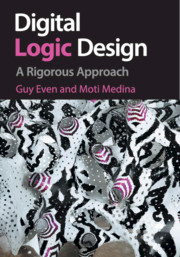Book contents
- Frontmatter
- Contents
- List of Algorithms
- Preface
- PART I PRELIMINARIES
- PART II COMBINATIONAL CIRCUITS
- 9 Representations of Boolean Functions by Formulas
- 10* The Digital Abstraction
- 11 Foundations of Combinational Circuits
- 12 Trees
- 13 Decoders and Encoders
- 14 Selectors and Shifters
- 15 Addition
- 16 Signed Addition
- PART III SYNCHRONOUS CIRCUITS
- PART IV A SIMPLIFIED DLX
- Bibliography
- Index
16 - Signed Addition
from PART II - COMBINATIONAL CIRCUITS
Published online by Cambridge University Press: 05 November 2012
- Frontmatter
- Contents
- List of Algorithms
- Preface
- PART I PRELIMINARIES
- PART II COMBINATIONAL CIRCUITS
- 9 Representations of Boolean Functions by Formulas
- 10* The Digital Abstraction
- 11 Foundations of Combinational Circuits
- 12 Trees
- 13 Decoders and Encoders
- 14 Selectors and Shifters
- 15 Addition
- 16 Signed Addition
- PART III SYNCHRONOUS CIRCUITS
- PART IV A SIMPLIFIED DLX
- Bibliography
- Index
Summary
So far we have dealt with the representation of nonnegative integers by binary strings. Wealso designed combinational circuits that perform addition for nonnegative numbers represented by binary strings. How are negative integers represented? Can we add and subtract negative integers?
We refer to integers that are either positive, zero, or negative as signed integers. In this chapter, we deal with the representation of signed integers by binary strings. We focus on a representation that is called two's complement. We present combinational circuits for adding and subtracting signed numbers that are represented in two's complement representation. Although the designs are obtained by very minor changes of a binary adder designs, the theory behind these changes requires some effort.
REPRESENTATION OF NEGATIVE INTEGERS
We use binary representation to represent nonnegative integers. We now address the issue of representing positive and negative integers. Following programming languages, we refer to nonnegative integers as unsigned numbers and to negative and positive numbers as signed numbers.
There are three common methods for representing signed numbers: signmagnitude, one's complement, and two's complement.
- Type
- Chapter
- Information
- Digital Logic DesignA Rigorous Approach, pp. 228 - 244Publisher: Cambridge University PressPrint publication year: 2012



